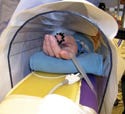Originally Published MDDI July 2006R&D DIGEST Maria Fontanazza
July 1, 2006
R&D DIGEST
|
During a procedure, surgeons may sometimes cause damage to nerves or tissue by leaning on a patient's leg or arm. A simple tube device could provide protection for patients. |
In the midst of performing a procedure, surgeons may occasionally lean an instrument or part of their own body against a patient's arms or legs. This, along with improper positioning of an extremity, can cause poor circulation and lead to tissue or nerve damage. A tubular device protects a patient's limbs in a most vulnerable state—during surgery. The device, developed at the University of Florida (Gainesville), protects limbs by shielding them during surgery and preventing them from obstructing medical equipment.
The AnestShield device snaps onto the arm board of an operating room table. It gives doctors access to the patient's hands, arms, and legs, which makes it easier for them to reach an intravenous catheter and monitor the depth of anesthesia. Holes in the material enable doctors to run intravenous tubes or lines for electrical monitoring. At about 15 × 6 × 8 in., the prototype is designed for an average-sized patient and can easily be resized. However, a new size can only be made if it will fit on a standard operating room arm board, which is about six inches across, says Harshdeep Wilkhu, MD, the device's creator. Most operating rooms only accommodate this standard size arm board, which limits the usefulness of the shield. If the arm-board surface could be made larger, it would allow the shield to be resized as well.
|
The device is made of a compound called Lexan. Wilkhu, clinical assistant professor of anesthesiology at the University of Florida, says that the lightweight polycarbonate is strong, very stiff, and easy to work with. Even if the shield were made an alternative size, the material would stay more or less the same, adds Wilkhu. The device is also impact resistant, so it protects the extremities from inadvertent bumping and pressing.
The prototype is designed to be used only when a patient is lying on his or her back. Slight modifications would need to be made to use the device when a patient is positioned on the stomach. It would also need to be modified to use it on a patient's legs, says Wilkhu. He suggests that incorporating straps into the shield would help secure the arm onto the board more effectively than using a towel to hold the arm in place.
The shield is ready for use. The technology has a pending patent application, and the university is seeking a manufacturer to license it.
Copyright ©2006 Medical Device & Diagnostic Industry
About the Author(s)
You May Also Like




